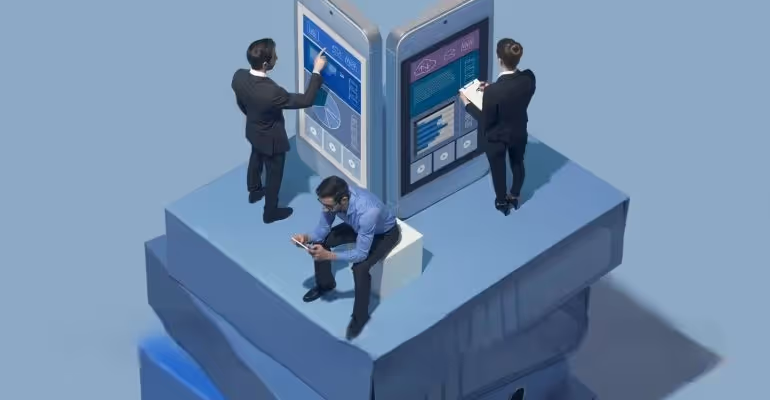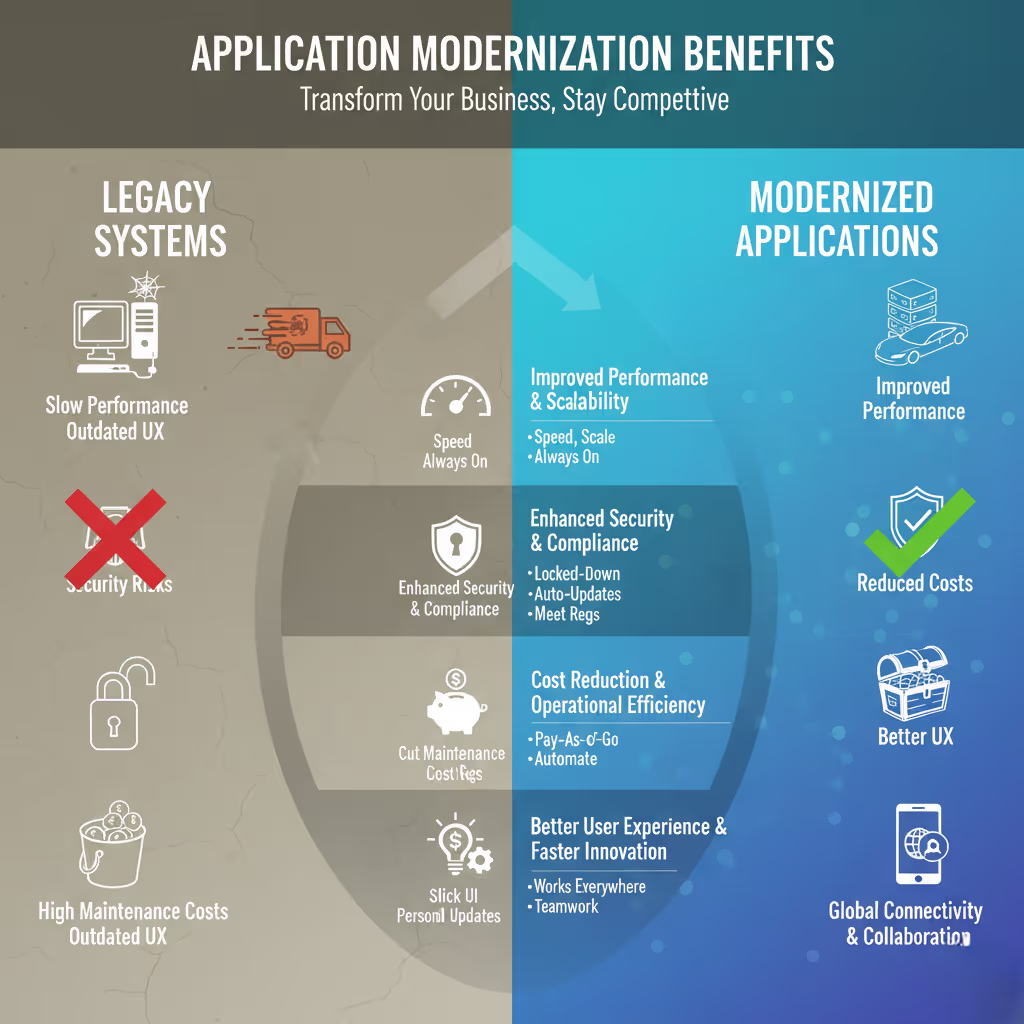Application Modernization: Benefits for US Firms

Application modernization benefits are reshaping how organizations stay competitive in today’s digital-first world. Legacy systems may have once fueled growth, but they now limit agility, security, and scalability. By modernizing applications, businesses can unlock efficiency, reduce costs, and embrace innovation faster. From enabling cloud adoption to improving customer experiences, application modernization benefits extend far beyond IT, driving long-term business success.
Application modernization benefits include lower costs, faster innovation, enhanced security, improved scalability, and better customer experiences. By upgrading legacy systems, businesses gain agility and resilience while preparing for a cloud-driven future.
Who Needs Application Modernization?
Ever wonder if your business is the only one stuck with outdated software? Spoiler: it’s not.
If you’re dealing with any of these, you need legacy system modernization:
- Your app crashes during a big sales push, like Black Friday chaos at a Miami retailer.
- You can’t scale up to handle more customers without a massive, budget-busting overhaul.
- Your old system’s a security risk, leaving you open to hackers or failing audits for laws like CCPA.
- Customers and employees hate your clunky interface, it’s like using a typewriter in a smartphone world.
- Your team’s stuck fixing old code instead of rolling out new features to beat competitors.
I’ve seen this frustration firsthand in tech meetups across the US, where IT leaders swap horror stories about systems that can’t keep up.
If you’re a CTO in Seattle, an IT Director in Atlanta, or a technical architect in Dallas, this is your wake-up call to modernize.
Application Modernization Benefits
So, why bother with application modernization? Because it can transform your business in ways that hit your bottom line and keep you competitive.
Here’s the good stuff:
Improved Performance and Scalability
Your old app’s probably wheezing under pressure. Modernizing makes it fast and flexible, like trading a rusty pickup for a Tesla.
- Speed That Wows: A Chicago retailer I worked with updated their e-commerce platform and cut checkout times in half, making customers happy.
- Scale Without Sweat: Cloud systems grow with your business, think a Denver startup handling a viral product launch without crashing.
- Always On: Modern setups keep running, even during peak times, unlike the downtime a Boston logistics firm faced with their old system.
- Ready for More: New apps handle bigger data and features, letting you add AI or analytics without starting over.
- Leaner Operations: Smarter systems use less server power, saving a New York hospital thousands on infrastructure.
Enhanced Security and Compliance
Old software’s like leaving your front door unlocked in a rough neighborhood. Modernizing keeps your data safe and your business legal.
- Locked-Down Systems: A Florida bank I know beefed up security with modern encryption, stopping hackers in their tracks.
- Auto-Updates: New systems patch themselves, unlike the manual fixes that kept a California IT team up all night.
- Compliance Without Panic: Meet CCPA or HIPAA easily, like a Texas healthcare provider did to pass audits with flying colors.
- Spot Threats Fast: Modern tools catch issues instantly, saving you from costly breaches.
- Protect Customer Data: Secure setups keep sensitive info safe, a must for any US business handling personal data.
Cost Reduction and Operational Efficiency
Legacy systems are money pits, constant fixes and old hardware eat your budget. Modernizing saves cash and makes life easier.
- Cut Maintenance Costs: Ditching technical debt saved a US manufacturer enough to hire new developers.
- Pay Only What You Need: Cloud platforms like AWS let you scale costs, unlike the pricey servers a Phoenix retailer ditched.
- Automate the Boring Stuff: Auto-backups and scaling free your team for big projects, like a Seattle firm I saw streamline operations.
- Simpler Systems: Clean code means less time troubleshooting, a relief for any IT crew.
- Save Long-Term: Modern setups are energy-efficient, cutting bills for eco-conscious US companies.
Better User Experience and Faster Innovation
Nobody likes a clunky app. Modern systems keep users happy and let you innovate fast.
- Slick Interfaces: A San Francisco retailer’s new app was so user-friendly, customer complaints dropped like a rock.
- Personalized Touches: Analytics let you tailor experiences, like a streaming service boosting subscriptions with custom playlists.
- Launch Features Fast: DevOps tools helped a US fintech roll out updates in days, not months.
- Works Everywhere: Modern apps shine on phones, web, and more, meeting users where they are.
- Teamwork Made Easy: Cloud tools let remote US teams collaborate, speeding up innovation.

Challenges in Application Modernization
Modernizing isn’t all smooth sailing. I’ve seen teams sweat bullets over these hurdles, but here’s how to tackle them:
Legacy System Complexity
Old systems are like a attic full of unlabeled boxes, good luck figuring out what’s inside.
- No Clue What’s Going On: Undocumented code makes it hard to know what’s critical.
- Everything’s Connected: One change can break something else, like a domino effect.
- Ancient Tech: Outdated systems lack support, making upgrades tricky.
- Fix It: Use tools like SolarWinds to map your system, as a US retailer did to get organized.
- Fix It: Have senior architects document key workflows to avoid surprises.
- Fix It: Update one piece at a time, like a Miami bank did to keep things running.
Technical Debt and Outdated Architectures
Years of quick fixes pile up technical debt, making every change a nightmare.
- Slow and Risky Changes: Patchwork code means updates take forever and break stuff.
- Rigid Systems: Monolithic apps can’t scale easily, unlike modern setups.
- Old Frameworks: COBOL or similar tech is a pain to work with today.
- Fix It: Refactor bit by bit, like a US insurance firm that sped up claims processing.
- Fix It: Switch to microservices for flexibility, as a Seattle startup did to grow fast.
- Fix It: Use tools like SonarQube to find and fix technical debt hotspots.
Data Migration Risks
Moving data to new systems is like moving a house, one wrong move, and things get messy.
- Weird Data Formats: Old data doesn’t always fit new systems, causing errors.
- Risk of Losing Data: A US manufacturer lost inventory records mid-migration, ouch.
- Validation Takes Time: Checking huge datasets is a slog.
- Fix It: Plan every step with checks to keep data safe, like a hospital I worked with.
- Fix It: Use ETL tools to make data fit, saving a US retailer from migration headaches.
- Fix It: Test in a sandbox first to catch problems before they hit your business.
Integration with Modern Tools
Old apps don’t play nice with new tech, slowing you down.
- No APIs: Legacy systems can’t connect to tools like Salesforce easily.
- Data Mismatches: Old formats mess up workflows with modern platforms.
- Innovation Blocks: Adding AI or IoT feels impossible without a rewrite.
- Fix It: Use middleware like MuleSoft, as a US retailer did to link their CRM.
- Fix It: Swap out old parts for cloud-native ones over time.
- Fix It: Grab pre-built connectors from AWS to make integration with modern tools smooth.
Downtime and Business Disruption
Nobody wants their business offline during a migration, it’s a revenue killer.
- Outages Hurt: A US e-commerce site lost sales during a botched migration.
- Testing Takes Time: Complex projects mean long delays if you’re not careful.
- Stakeholder Pushback: Teams fear disruptions and resist change.
- Fix It: Use blue-green deployments for downtime minimization, like a US logistics firm.
- Fix It: Run old and new systems together to keep things smooth.
- Fix It: Share clear plans to ease fears, as a New York bank did to win trust.
Skill Gaps and Change Resistance
Your team might not know the latest tech, and some folks just hate change.
- No Modern Skills: Cloud or DevOps expertise is hard to come by.
- Resistance to Change: Employees worry about new workflows disrupting their jobs.
- Hiring’s Tough: Top talent in the US is pricey and hard to find.
- Fix It: Train your team on AWS or Azure, like a US fintech did to upskill IT teams.
- Fix It: Ease fears with clear communication, as a Chicago manufacturer did.
- Fix It: Partner with experts like us to fill skill gaps without breaking the bank.
Unplanned Costs and Budget Overruns
Nobody likes a project that costs way more than planned.
- Hidden Issues: Unknown dependencies can jack up costs fast.
- Bad Strategies: Lift-and-shift migrations often disappoint, needing rework.
- Unexpected Expenses: Training or new infrastructure can sneak up on you.
- Fix It: Plan with extra budget for surprises, like a US retailer that stayed on track.
- Fix It: Use cloud tools to monitor costs in real time, saving headaches.
- Fix It: Work with managed services for modernization to keep costs down, like a US hospital did.
Strategies for Successful Application Modernization
Want to make modernization a win? Here’s how to do it right:
Thorough Assessment and Planning
You wouldn’t build a house without a blueprint, same goes for modernization.
- Know Your System: Map everything with tools like Dynatrace to spot risks.
- Talk to Everyone: Get input from IT, execs, and users to set clear goals.
- Set Targets: Aim for wins like faster apps or lower costs to measure success.
- Pick the Big Wins: Focus on systems that drive revenue or customer satisfaction.
- Make a Plan: Lay out timelines and resources, like a US bank did for a smooth rollout.
Incremental Modernization vs. Big Bang
Don’t rip out everything at once, go step by step.
- Replace Gradually: Swap out one piece at a time, like a US retailer’s inventory update.
- Seamless Switches: Use blue-green setups for downtime minimization.
- Test Small First: Roll out changes to a few users to catch bugs early.
- Show Quick Results: Modernize easy, high-impact areas to build momentum.
- Keep Checking: Track progress to stay on course with incremental modernization.
Leveraging Managed Services and External Expertise
You don’t have to do it all yourself, experts can help.
- Use the Cloud: AWS or Azure handle the heavy lifting for scaling and security.
- Bring in Pros: Firms like Hakuna Matata know managed services for modernization.
- Outsource the Small Stuff: Let others handle patching so your team focuses on strategy.
- Grab Ready-Made Tools: Use templates to speed things up and save money.
- Learn as You Go: Make sure partners teach your team to run the new system.
Upskilling Teams and Change Management
Get your team ready and excited for the change.
- Train Smart: Offer AWS or DevOps courses to upskill IT teams fast.
- Make Learning Fun: Let your team play with new tools to build confidence.
- Ease the Transition: Use clear communication to show why modernization rocks.
- Highlight Benefits: Show how it makes jobs easier, like a US manufacturer did.
- Get Buy-In: Involve your team early to make them feel part of the process.
Turning Modernization Challenges into Business Opportunities
Listen, application modernization isn’t easy, but it’s worth it. By tackling technical debt, data migration risks, and cloud migration challenges, you can make your business faster, safer, and ready to grow.
I’ve seen US companies, like a Florida logistics firm that slashed costs and sped up deliveries, turn old systems into competitive advantages. With a solid plan, you’ll fix today’s headaches and set yourself up to win in 2025’s fast-paced market.


